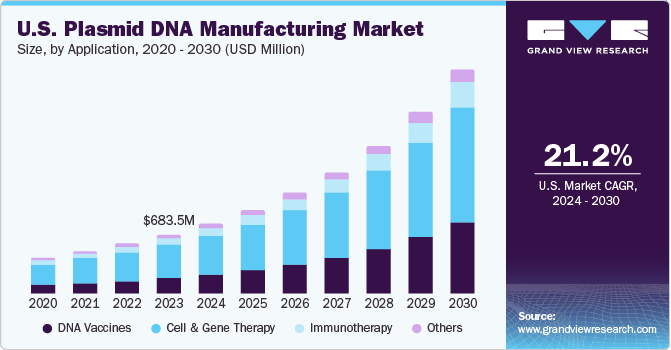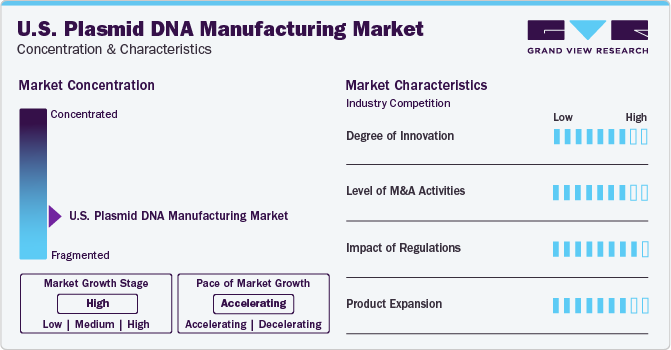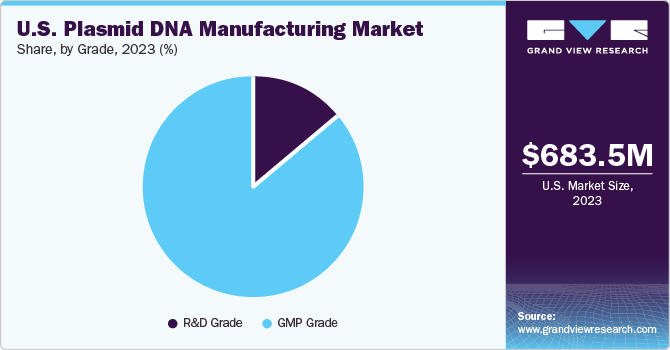- Home
- »
- Biotechnology
- »
-
U.S. Plasmid DNA Manufacturing Market, Industry Report, 2030GVR Report cover
![U.S. Plasmid DNA Manufacturing Market Size, Share & Trends Report]()
U.S. Plasmid DNA Manufacturing Market Size, Share & Trends Analysis Report By Disease (Cancer, Infectious Diseases), By Grade (R&D Grade, GMP Grade), By Application, By Development Phase, And Segment Forecasts, 2024 - 2030
- Report ID: GVR-4-68040-287-0
- Number of Report Pages: 90
- Format: PDF, Horizon Databook
- Historical Range: 2018 - 2023
- Forecast Period: 2024 - 2030
- Industry: Healthcare
Market Size & Trends
The U.S. plasmid DNA manufacturing market size was estimated at USD 683.5 million in 2023 and is projected to grow at a CAGR of 21.23% from 2024 to 2030. This can be attributed to advanced innovative manufacturing technologies adoption for production and rising engagement of key market players in research and product development in gene & cell therapy. In addition, homegrown companies are expanding their manufacturing facilities in the country as well.

Furthermore, along with established Contract Development and Manufacturing (CDMOs) in the country, several new manufacturing service providers are entering the market space. This is anticipated to further boost market growth in the country. Entry of new players coupled with the expansion of facilities by existing players has intensified the competition in the U.S. market. U.S. accounted for 38% of the U.S. plasmid DNA manufacturing market in 2023 owing to the presence of key market players, including CDMOs offering GMP manufacturing services. Moreover, considering the future scope and significance of gene therapy in human disease treatment, numerous companies in the U.S. are adopting various strategic initiatives to broaden their product portfolio.
These key players are focused on the development, maturation, and implementation of innovative technologies for cell therapy manufacturing. Moreover, supportive government legislation and favorable regulatory scenarios for gene therapies in the country are anticipated to fuel the demand for plasmid DNAs. For instance, in October 2021, the U.S. FDA, NIH, and 10 pharmaceutical companies partnered to develop advanced gene therapies for rare genetic disorders. Such initiatives are likely to accelerate the demand for plasmid DNA as they have an important role in advanced therapeutics.
The demand for plasmid DNA in various medical therapies has been steadily increasing in recent years. Researchers are also focusing on the development of gene-based therapies for various diseases such as cancer and genetic disorders. Although the number of patients receiving gene therapies is less, the future of gene therapy holds great potential as it is expected to revolutionize the treatment regime by targeting the genes responsible for disease pathogenesis. As gene therapy continues to show promising results in clinical trials, the demand for plasmid DNA for research and therapeutic purposes is expected to grow.
Market Concentration & Characteristics
The plasmid DNA manufacturing industry is highly competitive and fragmented due to the presence of established & mid-tier companies and startups. It is expected to witness lucrative growth owing to rising demand for high-throughput gene analysis techniques and increased adoption of cell & gene therapies. Companies are planning strategies such as expansion through acquisitions and partnerships, investment in R&D to maintain competitiveness in life sciences and healthcare industry, product launches, and emphasis on customer service, and support.

The introduction of groundbreaking technologies, such as genetic engineering in biotechnology, has accelerated the pace of genomic research, which is expected to drive the demand for the manufacturing of plasmid DNA for cell- & gene-based therapies. For instance, in January 2023, Charles River Laboratories International, Inc. announced the launch of eXpDNA plasmid platform to expedite DNA programs.
Competition in the market is high due to the presence of well-established players, medium-sized companies, and startups. The market entities are undertaking diverse strategies, such as mergers & partnerships, to strengthen their market presence For instance, in January 2022, Aldevron acquired Nature Technology Corporation (NTC), a producer of novel and exclusive plasmid constructions & production methods utilized in the field of cell & gene therapy.
Several regulatory authorities have published relevant guidelines in U.S in this regard. For instance, the U.S. FDA has published its Guidance for Industry: Considerations for Plasmid DNA Vaccines for Infectious Disease Indications. Under these guidelines, DNA vaccines are classified as biological products in section 351 of the PHS ACT which are regulated by FDA’s Center for Biologics Evaluation and Research. Furthermore, U.S. has a mix of both public and private health insurance. The public financing system includes federal & state governments, which provide reimbursement through Medicare and Medicaid programs.
Application Insights
The cell & gene therapy segment held the largest market share of 55.33% in 2023 owing to wide adoption of gene therapy for treating several genetically inherited diseases. Cell & gene therapy-based medicines are increasingly being adopted owing to the advent of next-generation transfer vectors and plasmid DNA technology.
The DNA vaccines segment is expected to witness the fastest CAGR from 2024 to 2030. The demand for these is rising due to its easy manufacturing process and can be accomplished along with manufacture of other traditional vaccines in large manufacturing units. Several plasmid DNA & viral vectors are being investigated for human use owing to their advantages. These are further being explored to assess potential and thereby accelerate the development of vaccines.
Disease Insights
The cancer segment held the largest market share of 41.90% in 2023 owing to the rising number of cancer cases in the U.S. due to poor diet choices, high consumption of alcohol, smoking, and physical inactivity. Although various cancer therapies have been proven efficacious, cancer deaths account for the majority of mortality cases.
The genetic disorder segment is expected to register a considerable CAGR from 2024 to 2030. There are many private & public companies in the U.S. focusing on this disease segment for the development of advanced gene therapy. More than 1500 ongoing clinical trials are directed toward the same in the U.S., making gene therapy for genetic disorders a very crucial segment for the market during forecast period.
Development Phase Insights
The clinical therapeutics segment held the largest market share of 55.23% in 2023. Genetic vaccination techniques and personalized treatment lines have increased the importance of plasmid DNA in clinical research activities. In addition, many therapies are under clinical trials for treatment of life-threatening diseases, such as HIV, HPV, and cancer. For instance, in October 2022, Ludwig Institute for Cancer Research completed phase I clinical trial of NY-ESO-1 Plasmid DNA for treatment of bladder, prostate, esophageal, and non-small cell lung cancer, and sarcomas.
The pre-clinical segment is expected to witness the fastest CAGR from 2024 to 2030. During the R&D stages, plasmid DNA is broadly utilized in pre-clinical trials for developing toxicology or bio-distribution studies. Thus, the market for pre-clinical plasmid DNA therapeutics is expected to witness significant growth over the forecast period, owing to broad development pipeline for gene therapy and vaccines.
Grade Insights
The GMP grade segment held the largest market share of 85.89% in 2023 owing to an increasing number of clinical developments of cell & gene therapy and DNA vaccines and continuous approvals of newly marketed therapies. Furthermore, multiple regulations have been laid down for GMP manufacturing of plasmids, which further support advanced therapy developers.
The R&D grade segment is expected to witness the fastest CAGR from 2024 to 2030. Plasmid DNA has gained immense attention due to rising demand and wide applications. Vast applications of R&D grade plasmid DNA generate high demand for this product in research settings and also in drug development & discovery fields by therapy developers. Manufacturing facility and technology advancements are expected to drive the adoption rate of R&D-grade pDNAs over the forecast period.

Key U.S. Plasmid DNA Manufacturing Company Insights
Some prominent U.S. plasmid DNA manufacturing market companies include Charles River Laboratories; VGXI, Inc.; Lonza; Danaher; Kaneka Corporation; Cell and Gene Therapy Catapult; and VectorBuilder, Inc. These companies are focusing on delivering advanced products to the market for building an extensive product portfolio.
These players are striving to gain market position by partnering and collaborating and gaining licenses from innovators to enhance their market presence. Geographic expansion is another most adopted strategy by these prominent players. Furthermore, extensive R&D initiatives are being undertaken by local players for cancer mitigation, as a result of continuous public-private funding.
Recent Developments
Key U.S. Plasmid DNA Manufacturing Companies:
- Charles River Laboratories
- VGXI, Inc.
- Danaher (Aldevron)
- Kaneka Corp.
- Nature Technology
- Cell and Gene Therapy Catapult
- Eurofins Genomics
- Lonza
- Luminous BioSciences, LLC
- Akron Biotech
-
In January 2024, Charles River Laboratories International, Inc. announced the launch of a Rep/Cap plasmid that will be available off the shelf for enhancing adeno-associated virus-based gene therapy programs
-
In August 2023, Charles River Laboratories International, Inc. announced a collaboration with Fondazione Telethon for high-quality plasmid manufacturing for the production of GMP-compliant HQ plasmid DNA batches
-
In January 2023, KromaTiD announced the launch of a plasmid DNA manufacturing service that is integral for novel vaccines and gene therapeutics development
-
In April 2022, Akron Biotech opened a new cGMP plasmid DNA manufacturing facility in Florida. With this new facility, the company planned to address the evolving demand for gene therapies & vaccines.
U.S. Plasmid DNA Manufacturing Market Report Scope
Report Attribute
Details
Market size value in 2023
USD 683.5 million
Revenue forecast in 2030
USD 2.56 billion
Growth rate
CAGR of 21.23% from 2024 to 2030
Actual data
2018 - 2023
Forecast period
2024 - 2030
Quantitative units
Revenue in USD million/billion and CAGR from 2024 to 2030
Report coverage
Revenue forecast, company ranking, competitive landscape, growth factors, and trends
Segments covered
Grade, development phase, application, disease
Country scope
U.S.
Key companies profiled
Charles River Laboratories; VGXI, Inc.; Danaher (Aldevron); Kaneka Corp.; Nature Technology; Cell and Gene Therapy Catapult; Eurofins Genomics; Lonza; Luminous BioSciences, LLC; Akron Biotech
Customization scope
Free report customization (equivalent up to 8 analyst’s working days) with purchase. Addition or alteration to country, regional & segment scope.
Pricing and purchase options
Avail customized purchase options to meet your exact research needs. Explore purchase options
U.S. Plasmid DNA Manufacturing Market Report Segmentation
This report forecasts revenue growth at the country level and provides an analysis of the latest industry trends in each of the sub-segments from 2018 to 2030. For this study, Grand View Research has segmented the U.S. plasmid DNA manufacturing market report based on grade, development phase, application, and disease:
-
Grade Outlook (Revenue, USD Million, 2018 - 2030)
-
R&D Grade
-
GMP Grade
-
-
Development Phase Outlook (Revenue, USD Million, 2018 - 2030)
-
Pre-Clinical Therapeutics
-
Clinical Therapeutics
-
Marketed Therapeutics
-
-
Application Outlook (Revenue, USD Million, 2018 - 2030)
-
DNA Vaccines
-
Cell & Gene Therapy
-
Immunotherapy
-
Others
-
-
Disease Outlook (Revenue, USD Million, 2018 - 2030)
-
Infectious Disease
-
Cancer
-
Genetic Disorder
-
Others
-
Frequently Asked Questions About This Report
b. The U.S. plasmid DNA manufacturing market size was estimated at USD 683.5 million in 2023.
b. The U.S. plasmid DNA manufacturing market is expected to grow at a compound annual growth rate of 21.23% from 2024 to 2030 to reach USD 2.57 billion by 2030.
b. The cancer disease segment dominated the U.S. plasmid DNA manufacturing market with the largest market share of 41.90% in 2023.
b. Some key players operating in the U.S. plasmid DNA manufacturing market include Charles River Laboratories, VGXI, Inc., Aldevron, KANEKA CORPORATION, Nature Technology, Cell and Gene Therapy Catapult, Eurofins Genomics, Lonza, and others.
b. Key factors driving market growth include increasing awareness about cell and gene therapy. Moreover, increasing demand for plasmid DNA is also estimated to accelerate market growth.
Share this report with your colleague or friend.
![gvr icn]()
NEED A CUSTOM REPORT?
We can customize every report - free of charge - including purchasing stand-alone sections or country-level reports, as well as offer affordable discounts for start-ups & universities. Contact us now
![Certified Icon]()
We are GDPR and CCPA compliant! Your transaction & personal information is safe and secure. For more details, please read our privacy policy.
We are committed towards customer satisfaction, and quality service.
"The quality of research they have done for us has been excellent."





